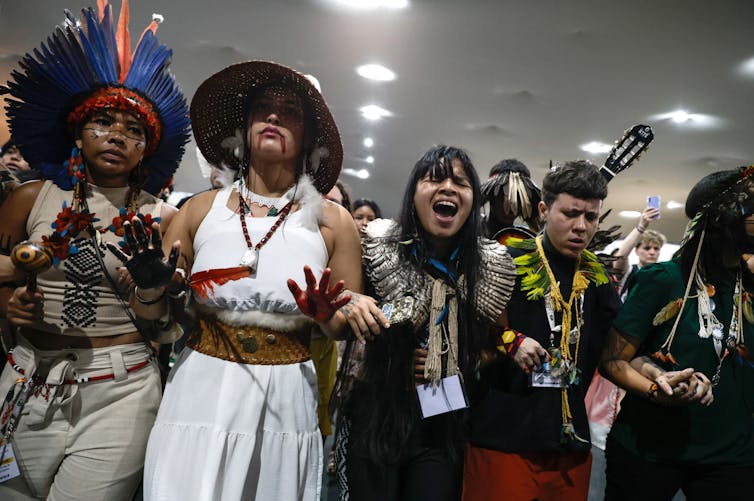- Home
Edition
Africa Australia Brasil Canada Canada (français) España Europe France Global Indonesia New Zealand United Kingdom United States Edition:
Global
Edition:
Global
- Africa
- Australia
- Brasil
- Canada
- Canada (français)
- España
- Europe
- France
- Indonesia
- New Zealand
- United Kingdom
- United States
 Academic rigour, journalistic flair
Academic rigour, journalistic flair
 Andre Borges / EPA
Cop30: five reasons the UN climate conference failed to deliver on its ‘people’s summit’ promise
Published: November 23, 2025 9.27pm GMT
Simon Chin-Yee, Mark Maslin, Priti Parikh, UCL
Andre Borges / EPA
Cop30: five reasons the UN climate conference failed to deliver on its ‘people’s summit’ promise
Published: November 23, 2025 9.27pm GMT
Simon Chin-Yee, Mark Maslin, Priti Parikh, UCL
Authors
-
 Simon Chin-Yee
Simon Chin-Yee
Lecturer in International Development, UCL
-
 Mark Maslin
Mark Maslin
UCL Professor of Earth System Science and UNU Lead for Climate, Health and Security, UCL
-
 Priti Parikh
Priti Parikh
Professor of Infrastructure Engineering and International Development, UCL
Disclosure statement
Mark Maslin is Pro-Vice Provost of the UCL Climate Crisis Grand Challenge and Founding Director of the UCL Institute for Sustainable Aviation and Aeronautics. He was co-director of the London NERC Doctoral Training Partnership and is a member of the Climate Crisis Advisory Group. He is an advisor to Sheep Included Ltd, Lansons, NetZeroNow and has advised the UK Parliament. He has received grant funding from the NERC, EPSRC, ESRC, DFG, Royal Society, DIFD, BEIS, DECC, FCO, Innovate UK, Carbon Trust, UK Space Agency, European Space Agency, Research England, Wellcome Trust, Leverhulme Trust, CIFF, Sprint2020, and British Council. He has received funding from the BBC, Lancet, Laithwaites, Seventh Generation, Channel 4, JLT Re, WWF, Hermes, CAFOD, HP, Royal Institute of Chartered Surveyors, John Templeton Foundation, The Nand & Jeet Khemka Foundation, Quadrature Climate Foundation.
Professor Priti Parikh is the Director of UCL's Bartlett School of Sustainable Construction and Vice Dean International for Bartlett Faculty of Built Environment. She is a Fellow and Trustee for Institution of Civil Engineers. Research funding sources include UKRI, Royal Academy of Engineering, Water Aid, British Academy, Bboxx Ltd, UCL, Royal Society and British Council. Her consultancy has received funding from AECOM, Cambridge Institute for Sustainable Leadership, Water and Sanitation for the Urban Poor, UNHABITAT, Arup, ITAD and GTZ
Simon Chin-Yee does not work for, consult, own shares in or receive funding from any company or organisation that would benefit from this article, and has disclosed no relevant affiliations beyond their academic appointment.
Partners
University College London provides funding as a founding partner of The Conversation UK.
View all partners
DOI
https://doi.org/10.64628/AB.j436a4ftg
https://theconversation.com/cop30-five-reasons-the-un-climate-conference-failed-to-deliver-on-its-peoples-summit-promise-269750 https://theconversation.com/cop30-five-reasons-the-un-climate-conference-failed-to-deliver-on-its-peoples-summit-promise-269750 Link copied Share articleShare article
Copy link Email Bluesky Facebook WhatsApp Messenger LinkedIn X (Twitter)Print article
As the sun set on the Amazon, the promise of a “people’s Cop” faded with it. The latest UN climate summit – known as Cop30, hosted in the Brazilian city of Belém – came with the usual geopolitics and the added excitement of a flood and a fire.
The summit saw Indigenous protests on an unprecedented scale, but the final negotiations were once again dominated by fossil fuel interests and delaying tactics. After ten years of climate (in)action since the Paris agreement, Brazil promised Cop30 would be an “implementation Cop”. But the summit failed to deliver, even as the world recorded a devastating 1.6˚C of global warming last year.
Here are our five key observations:
1. Indigenous groups were present – but not involved
Located in Amazonia, this was branded the summit for those on the frontlines of climate change. Over 5,000 Indigenous people were there, and they certainly made their voices heard.
However, only 360 secured passes to the main negotiating “blue zone”, compared to 1,600 delegates linked to the fossil fuel industry. Inside the negotiating rooms it was business as usual, with Indigenous groups remaining as observers, unable to vote or attend closed-door meetings.
The choice of location was nicely symbolic but logistically tough. Hosting the conference in the Amazon cost hundreds of millions of dollars in a region where many still lack basic amenities.
A stark image of this inequality: with hotel rooms full, the Brazilian government even docked two cruise ships for delegates, which per head can have eight times the emissions of a five star hotel.
2. The power of protests
But this was the second largest UN climate summit ever, and the first since Glasgow Cop26 in 2021 to take place in a country that permits real public protest. That mattered. Protests of various sizes happened every day during the two-week conference, most notably an Indigenous-led “great people’s march” on the middle Saturday.
 Indigenous protesters scored some small wins – but weren’t involved in the main talks.
Fraga Alves / EPA
Indigenous protesters scored some small wins – but weren’t involved in the main talks.
Fraga Alves / EPA
The visible pressure helped obtain recognition of four new Indigenous territories in Brazil. It showed that when civil society has a voice it can secure wins, even outside of the main emissions negotiations.
3. US absence creates a vacuum – and an opportunity
In Donald Trump’s first turn as president, the US sent at least a skeletal group of negotiators. This time, in a historic first, America did not send an official delegation at all.
Trump recently described climate change as “the greatest con job ever perpetrated on the world”, and since returning to power the US has slowed renewables and expanded oil and gas. It even helped scuttle plans for a net zero framework for global shipping last month.
As the US is rolling back its ambition, it is allowing other oil producing countries like Saudi Arabia to ignore their own climate pledges and to try and undermine others.
China has stepped into the void and become one of the loudest voices in the room. As the world’s largest supplier of green technology, Beijing used Cop30 to promote its solar, wind and electric vehicle industries and court countries looking to invest.
But for many delegates, the absence of America came as a relief. Without the distraction of the US attempting to “burn the house down” as it did at the shipping negotiations, the conference was able to get on with the business at hand: negotiating texts and agreements that will limit global warming.
4. ‘Implementation’ through side deals – not the main stage
So what was actually implemented? This year, the main action happened through voluntary pledges, not the binding global agreement.
The Belém pledge, backed by countries including Japan, India and Brazil, committed signatories to quadruple sustainable fuels production and use by 2035.
Brazil also launched a major trust fund for forests, with around US$6 billion (£4.6 billion) already pledged for communities working to protect rainforests. The EU followed by pledging new funds for the Congo Basin, the world’s second largest rainforest.
These are useful steps, but they highlight how the biggest advances at UN climate summits now often happen in the margins, rather than in the main talks.
The outcome of those main talks at Cop30 – the Belém package – is weak, and will get us nowhere near the Paris agreement’s target of limiting global warming to 1.5˚C. Most striking is the absence of the words “fossil fuels” from the final text even though they were central to the Glasgow climate pact (2021) and the UAE consensus (2023) – and of course they represent the main cause of climate change.
5. The Global Mutirão text: a missed opportunity
One potential breakthrough did emerge in negotiating rooms: the Global Mutirão text, a proposed roadmap to “transition away” from fossil fuels. More than 80 countries signed it, from EU members to climate-vulnerable Pacific island states.
Tina Stege, climate envoy for one of those vulnerable states, the Marshall Islands, urged delegates: “Let’s get behind the idea of a fossil fuel roadmap, let’s work together and make it a plan.”
 On the final Thursday, a small fire broke out in the pavilion area of the summit.
Brazil Photo Press / Alamy
On the final Thursday, a small fire broke out in the pavilion area of the summit.
Brazil Photo Press / Alamy
But opposition from Saudi Arabia, India and other major fossil fuel producers watered it down. Negotiations stretched into overtime, not helped by a fire that postponed discussions for a day.
When the final deal was agreed, key references to a fossil fuel phase-out were missing. There was a backlash from Colombia, due to the lack of inclusion of transition away from fossil fuels, which forced the Cop presidency to offer a six-month review as an olive branch.
This was hugely disappointing, as earlier in the summit there seemed to be huge momentum.
A widening gulf
So this was another divisive climate summit. The gulf between oil-producing countries (in particular in the Middle East) and the rest of the world has never been wider.
One positive to come out of the summit was the power of organised people: Indigenous groups and civil society made their voices heard, even if they weren’t translated into the final text.
With next year’s summit to be held in Turkey, these annual climate summits are increasingly migrating to nations with authoritarian leanings where protests are not welcome or completely banned. Our leaders keep stating that time is running out, yet negotiations themselves remain stuck in never ending circles of delays.
- Climate change
- UN Climate summit
- Give me perspective
- Cop30
Events
Jobs
-
 Lecturer in Paramedicine
Lecturer in Paramedicine
-
 Associate Lecturer, Social Work
Associate Lecturer, Social Work
-
 Lecturer, Communication Design
Lecturer, Communication Design
-
 Leading Research Centre Coordinator
Leading Research Centre Coordinator
-
 Chairperson, Animal Ethics
Chairperson, Animal Ethics
- Editorial Policies
- Community standards
- Republishing guidelines
- Analytics
- Our feeds
- Get newsletter
- Who we are
- Our charter
- Our team
- Partners and funders
- Resource for media
- Contact us
-
-
-
-
Copyright © 2010–2025, The Conversation

 Lecturer in Paramedicine
Lecturer in Paramedicine
 Associate Lecturer, Social Work
Associate Lecturer, Social Work
 Lecturer, Communication Design
Lecturer, Communication Design
 Leading Research Centre Coordinator
Leading Research Centre Coordinator
 Chairperson, Animal Ethics
Chairperson, Animal Ethics



